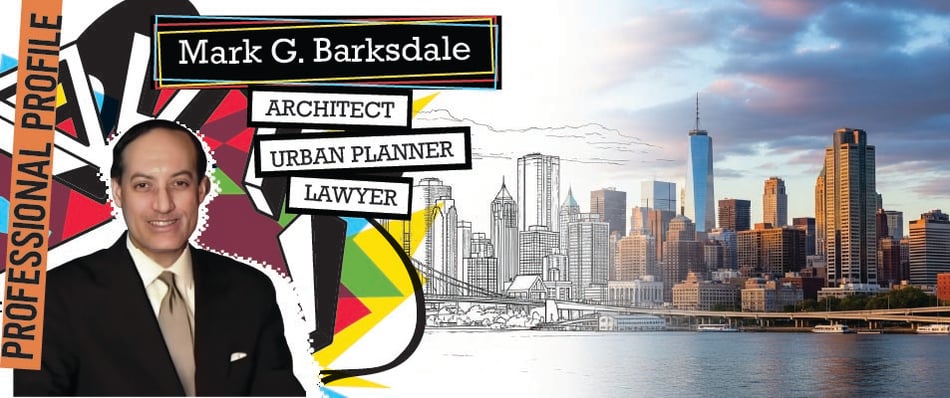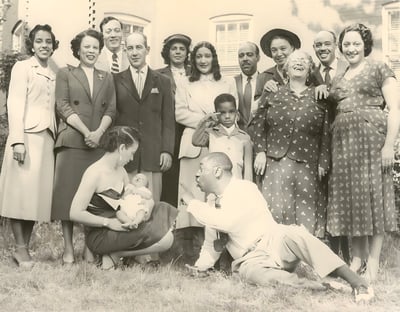Professional Profile: Mark G. Barksdale, AIA, NOMA, NCARB, MSUP/PP, JD

Architecture, urban planning and law, each of which are all-consuming disciplines, typically demand a lifetime of singular focus. Each profession branches into numerous subspecialties, requiring mastery of not only the technical minutia, but also development of an individual and creative vision that shapes distinctive solutions within each field. However, for one man, a career in architecture was not complete without a foundation in urban planning and the law. As he would in many aspects of his life, Mark G. Barksdale chose all three. In today's professional profile, we'll learn about a man who, when confronted with three roads in the woods, chose to venture down all three - and when there was no road, he built one himself.
Washington, DC + NYC Beginnings
Mark G. Barksdale was born in Washington, D.C. at the Columbia Hospital for Women, which overlooked Pennsylvania Avenue, just a few blocks away from the White House. It was the same hospital where bandleader Duke Ellington and former Vice President Al Gore were born. It’s also the city where his father was born and his mother came to live after they married. She moved from her home in Harlem, where she was born and raised in the milieu of the Harlem Renaissance. Mark was born in 1952, during the administration of President Harry S Truman, near the tail end of the era of racial segregation in America and before the Civil Rights era began.
 |
| A special baptism day for the Barksdale family. Baby Mark is held by family friend Helen Thompson Jackson, while her husband Willis "Fathead" Jackson tries to encourage a smile. The Jacksons had a business on the same block as Mark's grandfather's Barksdale Restaurant on 9th Street and U, in the heart of DC's African-American community. |
Mark was born into a city known for its’ beautiful architecture, historic monuments and a well thought-out urban design pattern of streets and traffic circles. It was also an environment that values education – he spent his early years just a few blocks away from Howard University, where three of his aunts in D.C. received their undergraduate degrees and were proud alumnae. At just three years of age, Mark’s life shifted north after the sudden death of his father, whereupon his mother's returned to her hometown of New York City, to live with her mother in a tenement building in the Morrisania section of the South Bronx. She soon re-married and Mark moved with his parents into the top floor apartment of a brownstone townhouse in Bedford-Stuyvesant, Brooklyn, owned by his mother’s uncle. As his mother and step-father began to have children together, the growing family then moved into a three-bedroom apartment in a newly-constructed “towers in the park” public housing development in the East Williamsburg/Bushwick section of Brooklyn.
All of these experiences living in different housing types in the “inner city” of New York City helped shape Mark’s lifelong awareness of the built environment. It was in Brooklyn that young Mark was educated and recognized as a budding intellect upon his placement in a program for Intellectually Gifted Children (IGC) in elementary school at the age of nine. He followed up his elementary school IGC program by skipping a year in junior high school and then entered Brooklyn Technical High School, one of the city’s top specialized high schools, which required passing a very rigorous entrance examination for admission.
After high school, Mark was one of a few students who was selected for admission to the tuition-free architecture program at the City College of New York (CCNY), the flagship college of the City University system in New York (CUNY). The reputation of CCNY was such that it gained the moniker of “The Harvard on the Hudson.” By then, he was still living at home with his parents, but they had moved into a single-family home that they had purchased in the borough of Queens, NY. It was a long two-hour commute each way between home and CCNY’s campus in Upper Manhattan, by both bus and subway train (before public transit became air-conditioned in NYC).
The long commute would serve a dual purpose, though: enabling Mark to acquire academic enrichment at a well-respected institution of higher education, while also immersing himself in the rich tapestry of the city’s built environment, which would inform his budding interest in architecture and urban planning. After earning his undergraduate degree at CCNY, Mark continued his education as a graduate student on a full fellowship at Columbia University’s Graduate School of Architecture, Planning and Preservation (GSAPP), where he earned two Master’s degrees: one in Health Services Planning and Design, and the other in Urban Planning. After working for several years to gain the experience necessary to qualify for the 4-day licensesure exam, he became a Registered Architect (R.A.) in New York. Later, he also gained licensure in New Jersey as both a Registered Architect and a licensed Professional Planner (P.P.).
Little did Mark know, though, that he was entering a profession where less than 2% of all licensed architects in the United States are African-American, according to the National Council of Architectural Registration Boards (NCARB). From his education and experience, Mark learned that architecture is an extremely difficult profession to enter as a licensed professional. As if becoming an architect wasn’t enough, Mark later returned to school to earn a Juris Doctor degree from Yale University’s School of Law, which was ranked as the #1 law school America at the time of his graduation in 1991,, according to U.S. News & World Report.
The quote, “architecture is frozen music,” has been attributed to the German poet Johann Wolfgang von Goethe. Taking that to heart, Mark added the study of music to his architectural studies and became a trained musician who performed as a percussionist with the Queens Festival Orchestra in New York, the Washington Heights Orchestra in New York, and toured with the Dance Theatre of Harlem percussion ensemble, including performances at the City Center Theatre in Manhattan’s Theatre District, as well as at the Shubert Theatre in Philadelphia, and the Symphony Theatre in Newark, NJ.
Practical Architecture + Prestige Architecture
At the City College of New York (CCNY), Barksdale studied architecture at a time when the curriculum often focused on abstract, elite design problems. With peers, he helped push for a design studio under Professor Arthur L. Symes that engaged students in projects connected to their own communities. This experience shaped Barksdale’s belief that architecture was not simply about aesthetics, but about relevance, equity, and service to diverse communities. He wanted to "design projects that were more relevant to the communities we came from, instead of the boat houses the other student were designing at the time." 1
That belief deepened through internships that placed him in starkly different architectural worlds. At the Architects Renewal Committee in Harlem (ARCH), one of the nation’s first community design centers, he gained experience as an undergrad with grassroots, community-driven design work and activism. During grad school at Columbia University, a summer internship with I.M. Pei’s prestigious Madison Avenue office offered him firsthand exposure to high modernism and the rigors of creating world-class design.
Barksdale’s education and training in the dual degree programs at Columbia University's Graduate School of Architecture prepared him for the technical demands of designing healthcare facilities with the broader vision of shaping cities, allowing him to operate across scales with equal fluency.
Architect + Lawyer
So how does one make the leap from architecture to law? "My initial interest for a career was in architecture," he explains, "But after I became licensed as an architect, I realized the business of architecture carries a significant amount of legal liability, so I thought it would be in my best interests to study law, not only as it pertains to architecture and land use, but also in all other aspects of a person’s business and personal life." To this end, Barksdale earned a Juris Doctor at Yale Law School, where he served as an editor of the Yale Law & Policy Review Journal.
With this foundation, he embarked on a career that combined architecture, planning, and law. His architectural practice included senior roles at the New York City Health and Hospitals Corporation, and consulting roles at HOK and Gensler, with projects ranging from a $150 million bus depot for New York’s Metropolitan Transportation Authority to a $70 million entertainment complex in Times Square for the Sony Corporation. As an attorney with Rogers & Wells, he practiced corporate, banking, and public finance law, further expanding his professional reach.
Public + Private
Barksdale’s career has always spanned private and public practice. From 2015-2017, he served as Director of Planning, Zoning, and Sustainability for the City of Newark, NJ, under Mayor Ras J. Baraka, having previously worked under Mayors Sharpe James and Cory Booker. There, he manages a multimillion-dollar budget and staff, guiding projects that represent billions in redevelopment and helping to shape the future of New Jersey’s largest city. His leadership has also extended to the profession itself, as a charter member of the NY Chapter of the National Organization of Minority Architects (NOMA), where he has mentored younger architects and worked to improve diversity in the field.
Planning + Designing
We asked Mr. Barksdale to share his thoughts on balancing the practical and the aesthetic in the context of large healthcare projects. His response captures the philosophy of starting with the user in mind: "Hospital architecture requires the ability to meet the needs of the physician staff, nursing staff, administrative staff, services staff and most importantly, the comfort, safety and security needs of patients and their belongings." This requires designing within the strict confines of numerous regulations and codes, which is a responsibility that requires mental agility and attention to detail.
Today + Tomorrow
What does the future hold for healthcare architecture? To answer, Mr. Barksdale again considers the user first. "Psychological health plays an important role in public health. Crowding, congestion and air quality in urban areas can produce stresses that eventually affect a person’s physical health. Open space and recreation areas are important components of neighborhood planning." This includes the need to keep infection control and prevention in mind when designing a healthcare space. He valued his consultations with the Infection Control Officer and the Infectious Disease Department when he was working as a resident architect pm the Facilities Department at Metropolitan Hospital on the Upper East Side of Manhattan. They "were always available to me for consultations regarding infection control measures we could implement in the hospital through design. For instance, in the Tuberculosis Clinic, it was required that we provide a blue light UV air purifier at the entrance to deactivate airborne microbes, such as viruses and bacteria. Environmental factors, including selection of building materials, were also very important considerations in the design of a healthcare facility."
As to what the future holds for Mr. Barksdale, we all can look forward to continued innovation. Mark Barksdale’s story is one of longevity and dualities, but also of synthesis. Architecture, urban planning and law, public and private, discipline and creativity, each found a place in his career. He is proof that the road less traveled need not be a choice between one or the other. Sometimes, the greatest visionaries take many roads to express their gifts for creating a better world.
This profile was created with the generous help of Mr. Barksdale, who shared both his time and his own words. Parts of his reflections have also been published in his personal writing and are included here with his approval.
1 “Mark G. Barksdale | Beyond the Built Environment.” Beyond the Built, 2025, www.beyondthebuilt.com/mark-barksdale. Accessed 12 Sept. 2025.
![EOScu Logo - Dark - Outlined [07182023]-01](https://blog.eoscu.com/hubfs/Eoscu_June2024/Images/EOScu%20Logo%20-%20Dark%20-%20Outlined%20%5B07182023%5D-01.svg)




